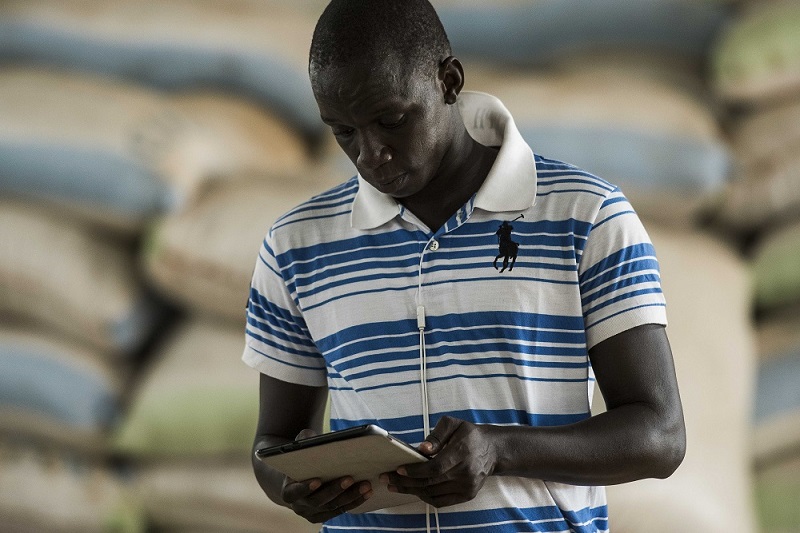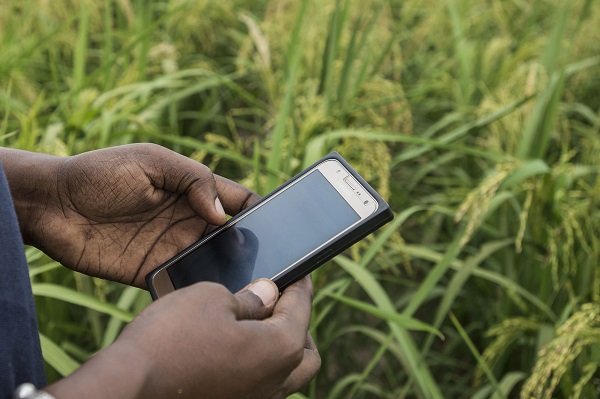Sep 20, 2018 | by Jo Anne Yeager Sallah, RTI International

Apps and international development projects go together like coffee and mornings. You can certainly have a morning without coffee, but the consensus is that your morning will go much better when you add some caffeine.
Top photo: A partner with the Feed the Future Senegal Naatal Mbay project uses his tablet to enter information at a rice paddy stock warehouse in Pont Gendarme, Senegal. Credit: Xaume Olleros/RTI International.
Introducing an app to help inform farmer decision-making sounds like a great idea. With the explosion of smartphone use in both rural and urban areas over recent years, apps provide the potential to reach and connect any combination of people who work across the agricultural value chain, from producers to millers to vendors to banks. They can be used to provide farmer extension services, track the market prices of commodities, or even rent farm equipment such as tractors. The possibilities are endless – but so are the potential pitfalls.
With initial development costs that are sometimes steep, as well as a significant time investment, project managers and business owners need to undertake some deep reflection before committing to developing an app to meet their objectives. Sustainability and scalability are critical considerations.
Some very innovative and trusted companies, such as Dimagi and Souktel, have found their niche providing both pre-packaged and custom smartphone applications for the private sector and NGO clients alike. They’ll be the first to tell you that the level of customization you use is probably the most important decision you’ll make after opting to employ an app in your project or business. While off-the-shelf choices can provide more time-tested and cost-efficient options, they can also be more limiting and, depending on your needs, less effective in ultimately achieving goals.

A Feed the Future Senegal Naatal Mbay partner checks information using his mobile device at a rice seed multiplication field in Taïf, Senegal. Credit: Xaume Olleros/RTI International
On the flip side of potentially limiting but more affordable off-the-shelf options, designing your own made-to-order app is highly appealing. And while the cost of development and deployment may be well within a project budget, it’s important to think through how the use of the app will evolve over time, what adjustments might be needed in the future, and who will be able to bear the cost and responsibility for those updates. According to our session speakers, the key to customizability is having a clear picture of what you want before app design begins.
This is potentially the most frustrating of the three pitfalls. Despite taking the time to invest in the development of your app – either off-the-shelf or custom-built – you’re not seeing the user uptake you expected. If an app isn’t reaching its target users, then it certainly isn’t worth developing. But how can you sufficiently plan to avoid these outcomes?
RTI International’s work with USAID in Senegal has highlighted some of the prerequisite conditions for maximizing adoption across systems and ways to avoid some common missteps. There, we’ve worked with over 100,000 farmers to help them collect and channel relevant data into practical applications to increase productivity, establish the ability to function in networks, share learning and good agricultural practices, access finance, and better link to markets. We've also worked with Dimagi to introduce an app to help farmer organizations collect their data and explore connections with other value chain partners more efficiently.
Working through local partners, we’ve seen the use of data take off and begin to scale up to a level that’s far exceeded our initial expectations. As the project comes to a close in 2019, we expect to see continued, long-term use of the data across value chain actors, a result that’s considered by many to be the hallmark of success for an agricultural development project.
Join the author, along with Anthony Connor of Dimagi and Hillary McCall of Souktel for the session, Show me the Data: ICT Solutions for Real-Time Agriculture Extension, to expand on this discussion and share your experiences and learn how they have avoided these pitfalls with apps for development at the 2018 SEEP Annual Conference on October 3 at 2:15-3:45 pm in Arlington.
Jo Anne Yeager Sallah is a senior food security and agriculture specialist with RTI International’s Food Security and Agriculture Division. She is currently the project manager for the Feed the Future Senegal Naatal Mbay project and was Chief of Party on the USDA-funded SeneGambia Cashew Value Chain Enhancement Project for 7 years prior to joining Naatal Mbay. She has lived and worked in West Africa for more than 20 years and has practical experience working with smallholder farmer organizations, and has promoted sustainable solutions that promote the use of data to improve agricultural decision-making.
Categories: Global Food Security Technology Sub-Saharan Africa Agriculture & Food Security English Blog WebinarsBlogs

1621 North Kent Street, Ste 900,
Arlington, VA, 22209
P 202.534.1400
F 703.276.1433
Website Photos: © mari matsuri
